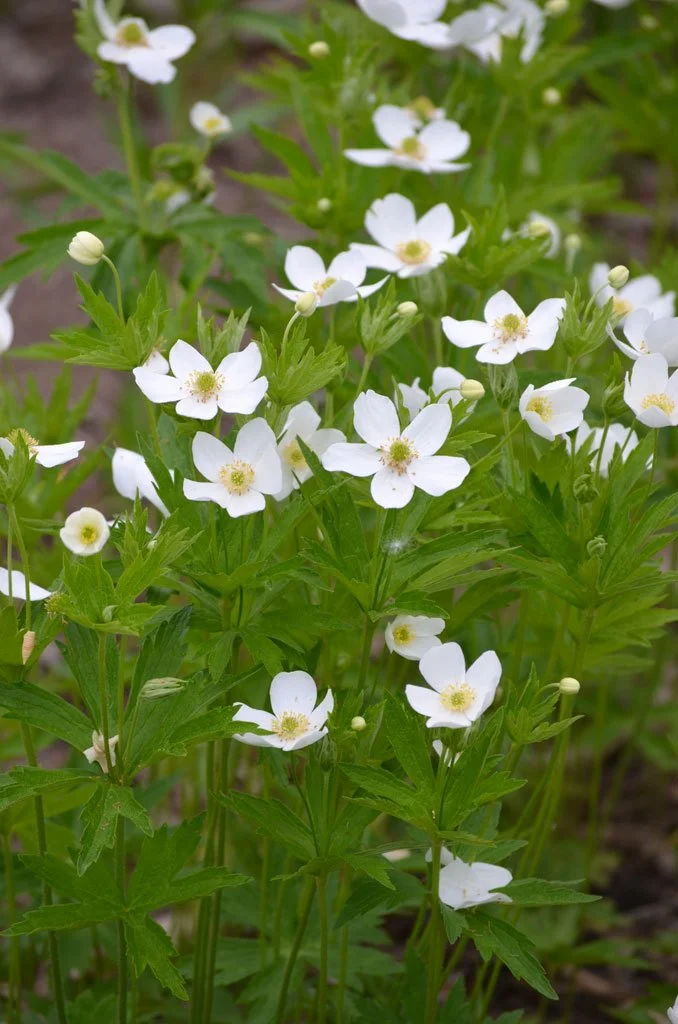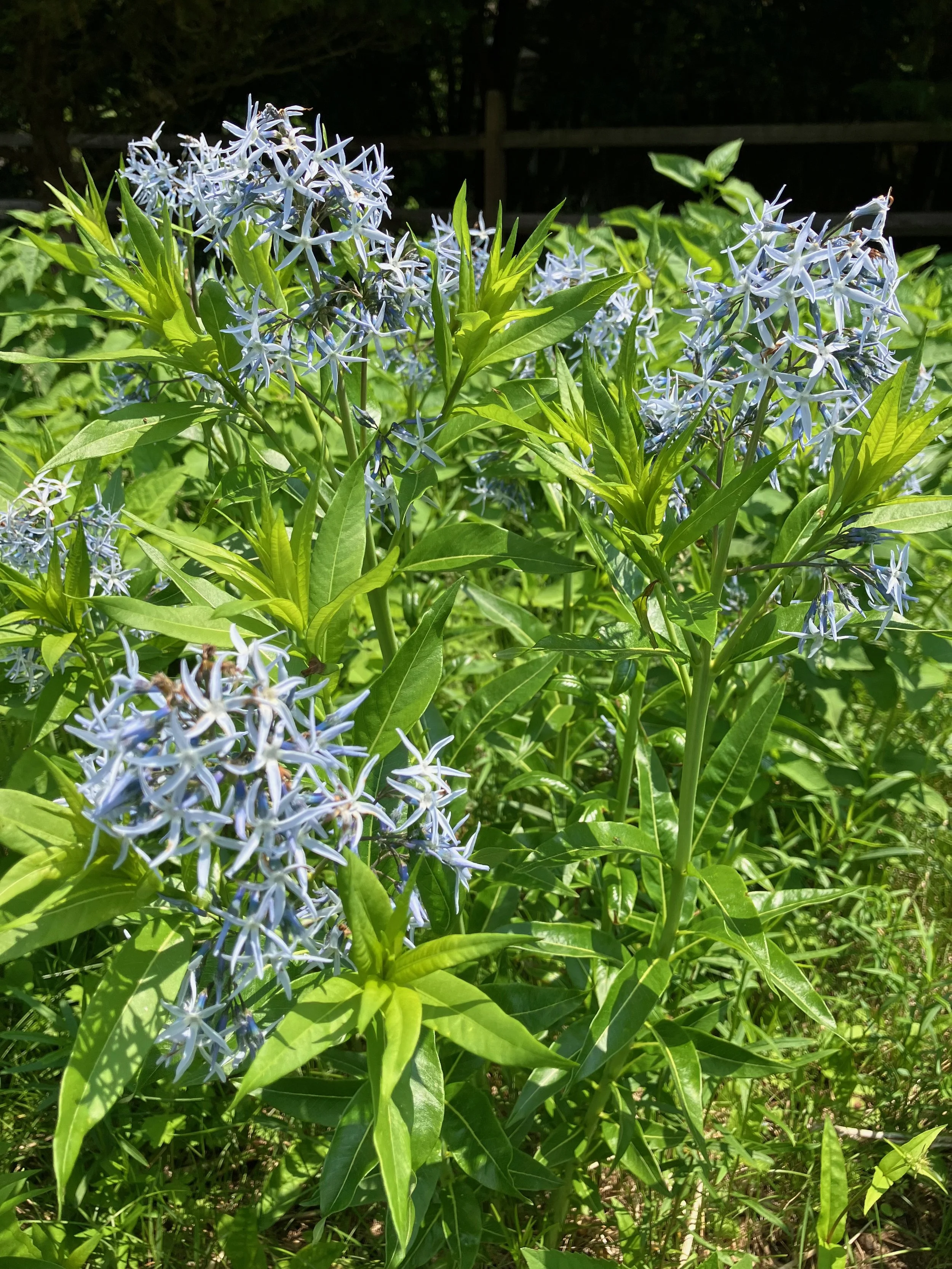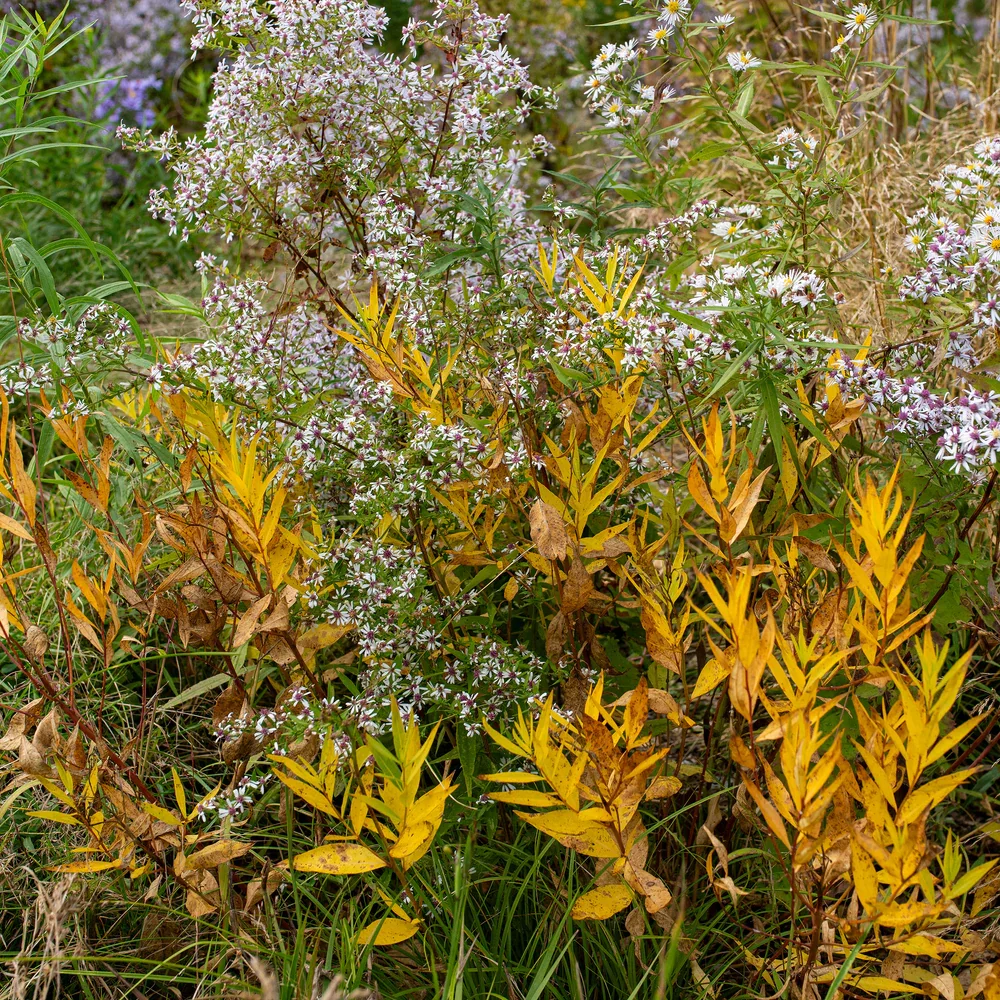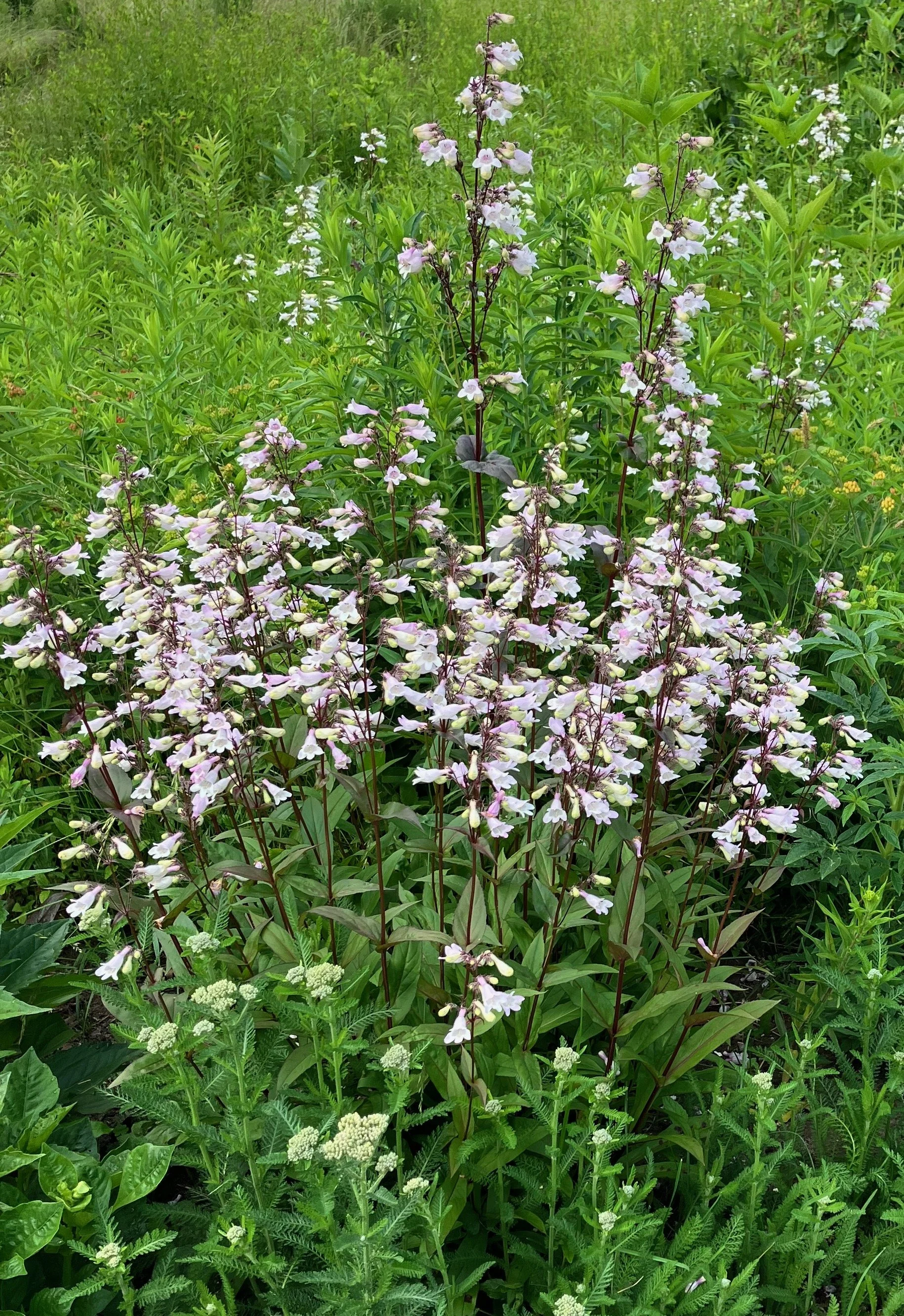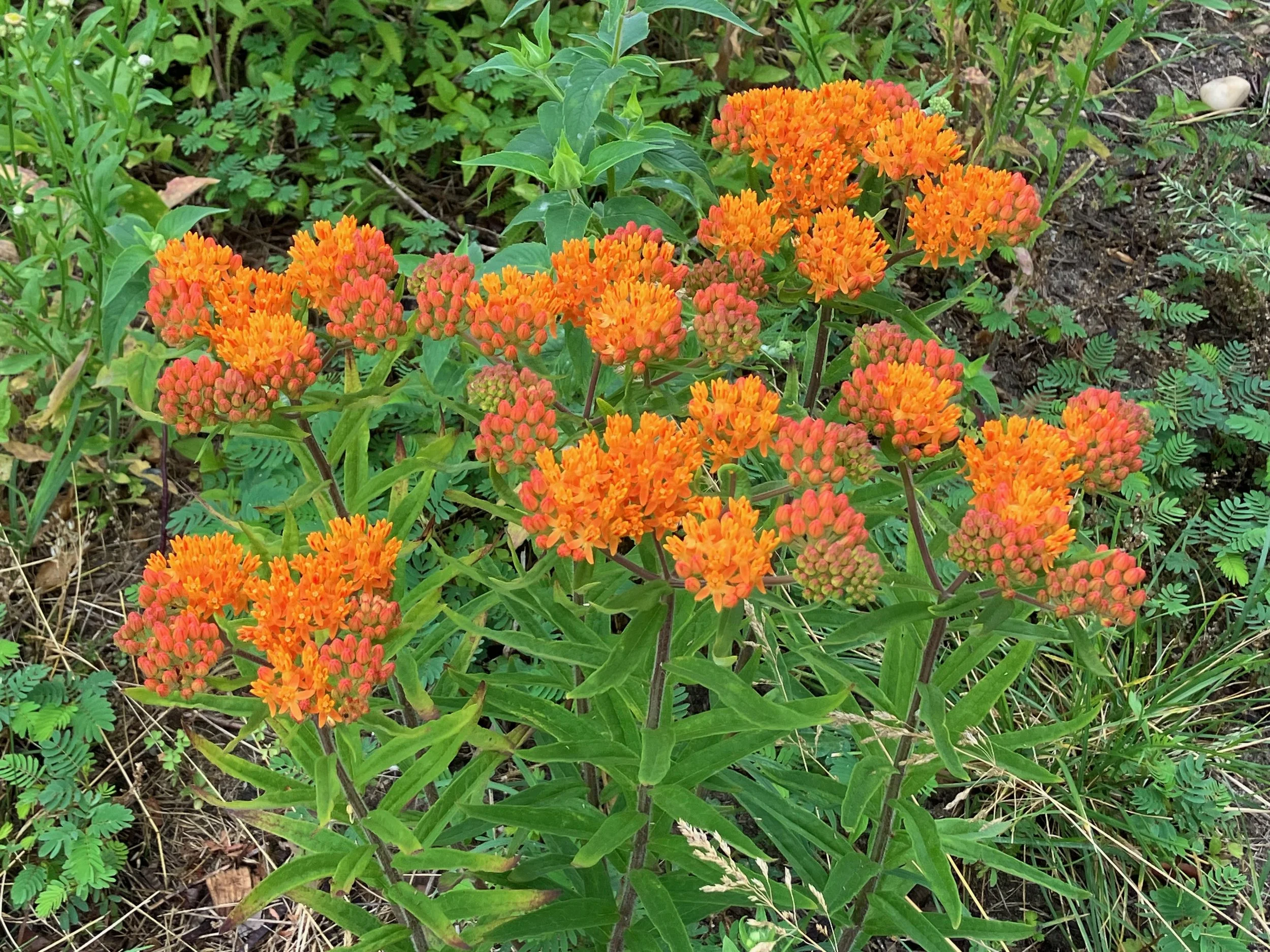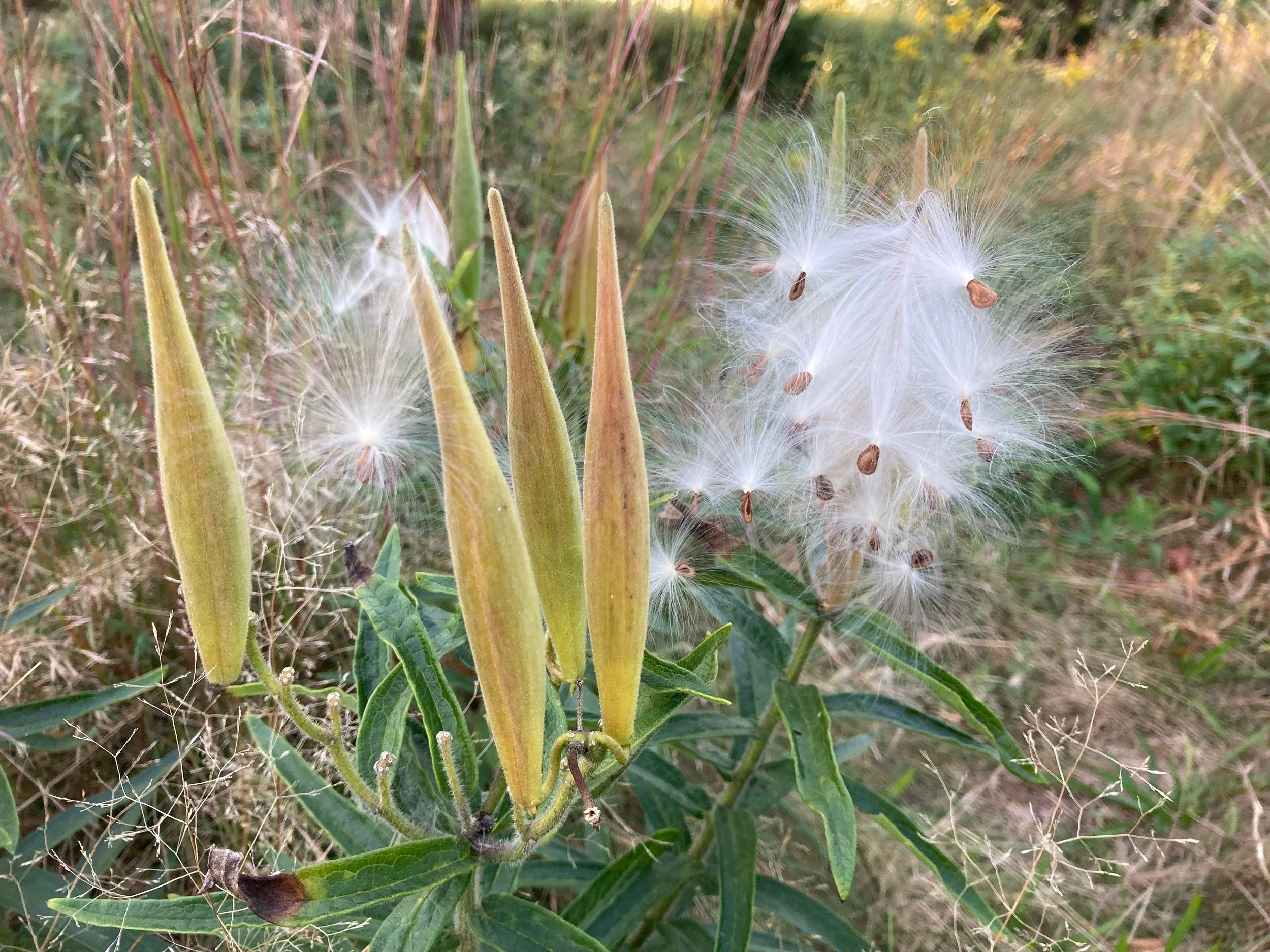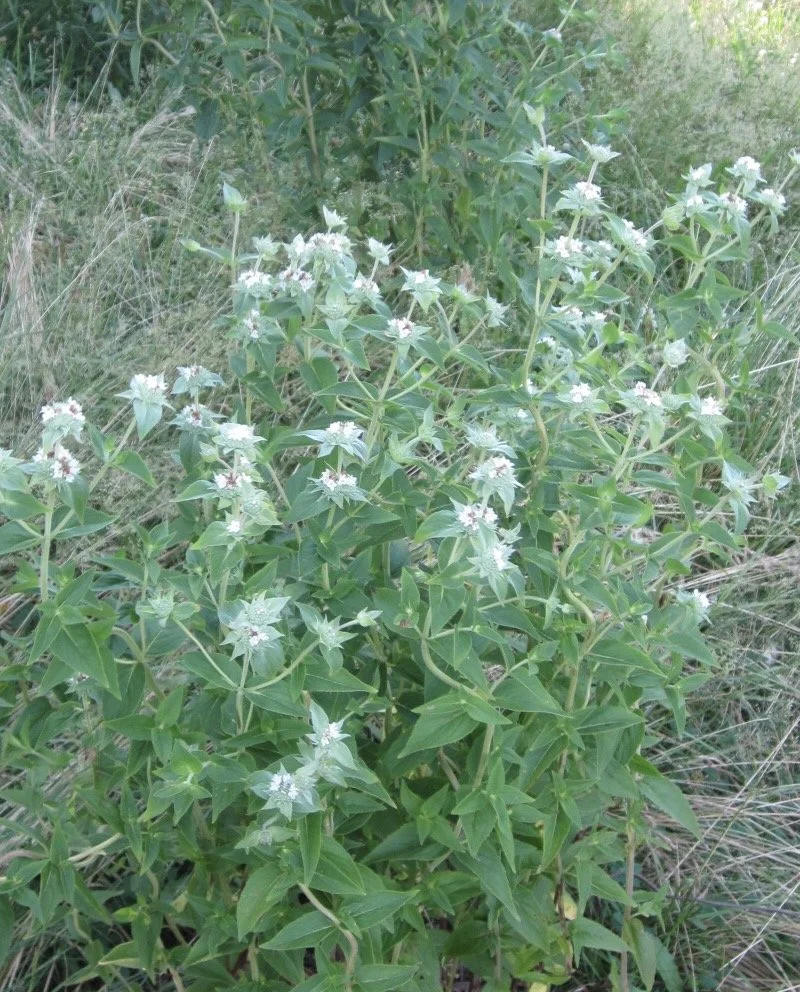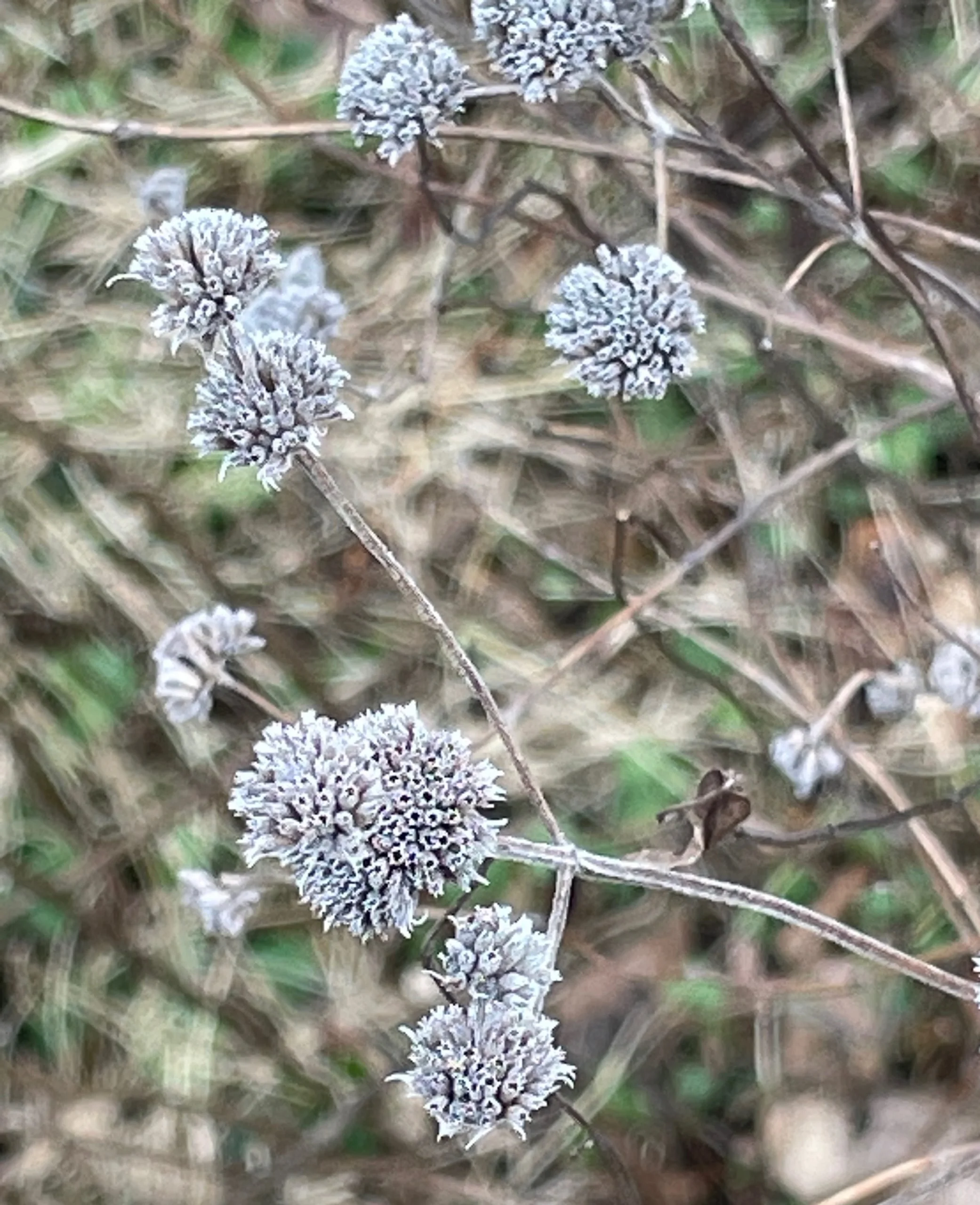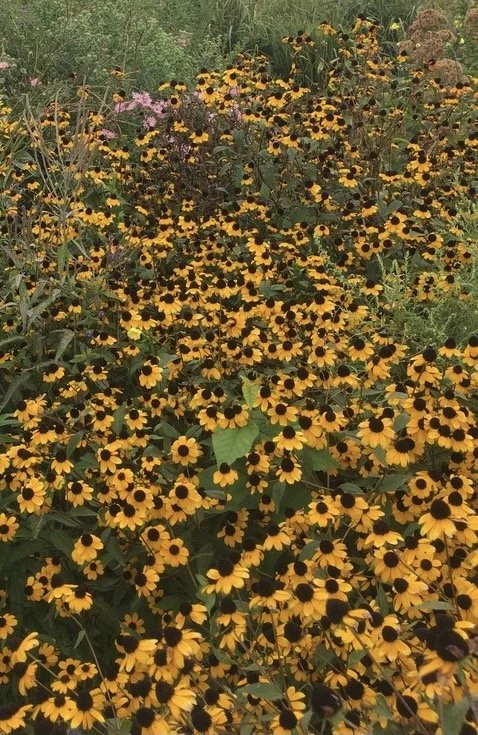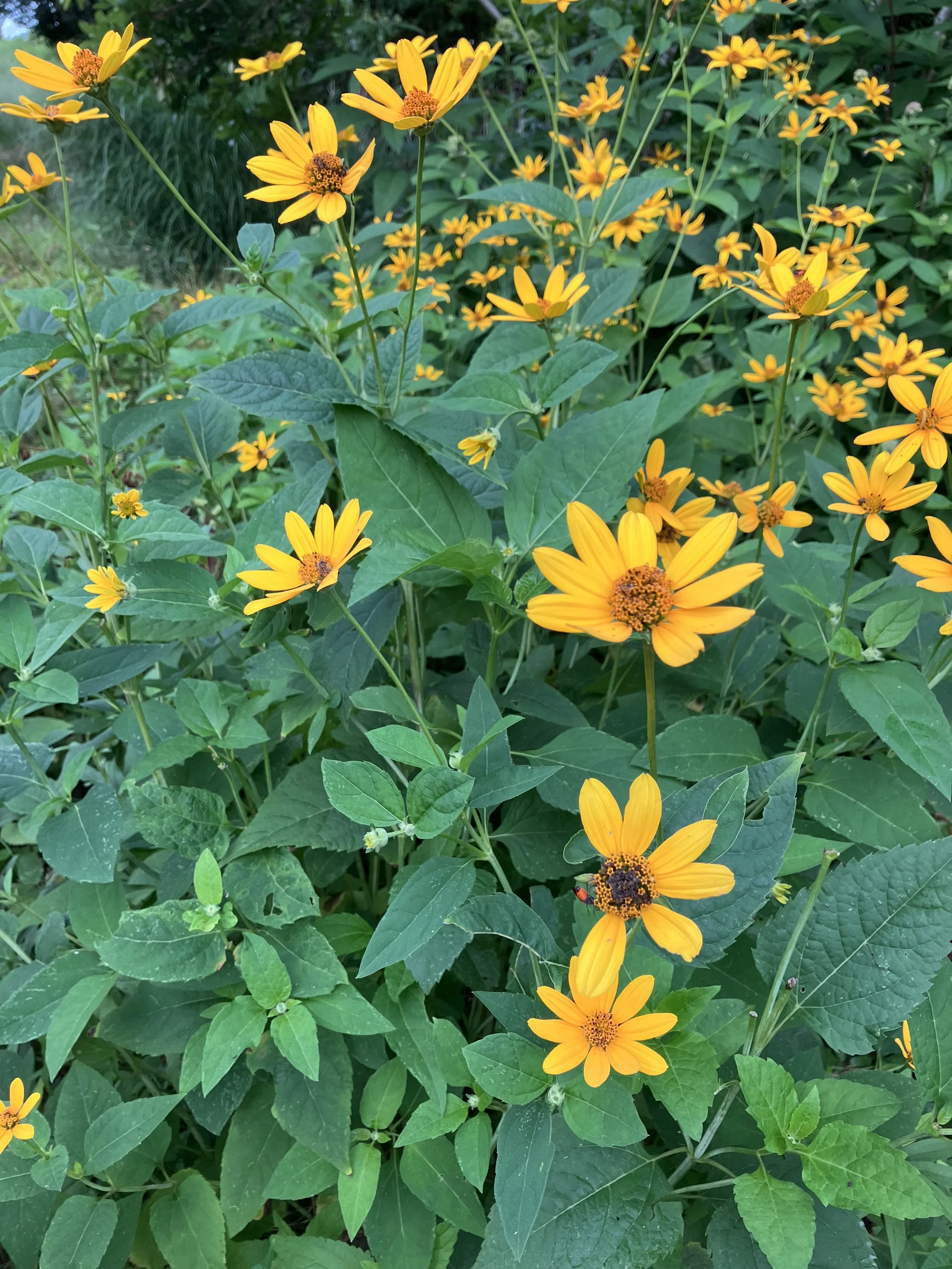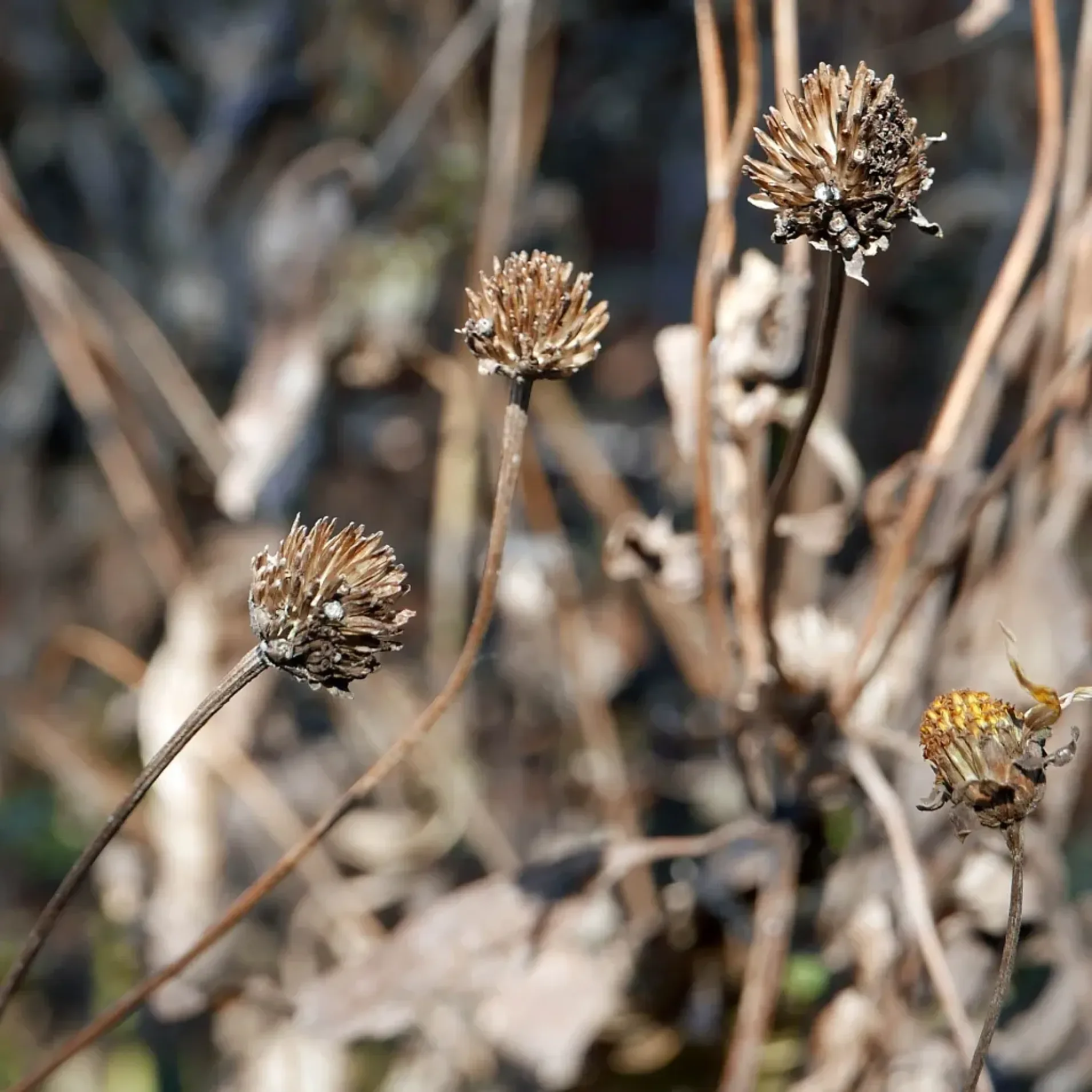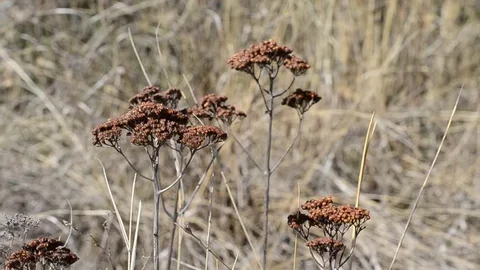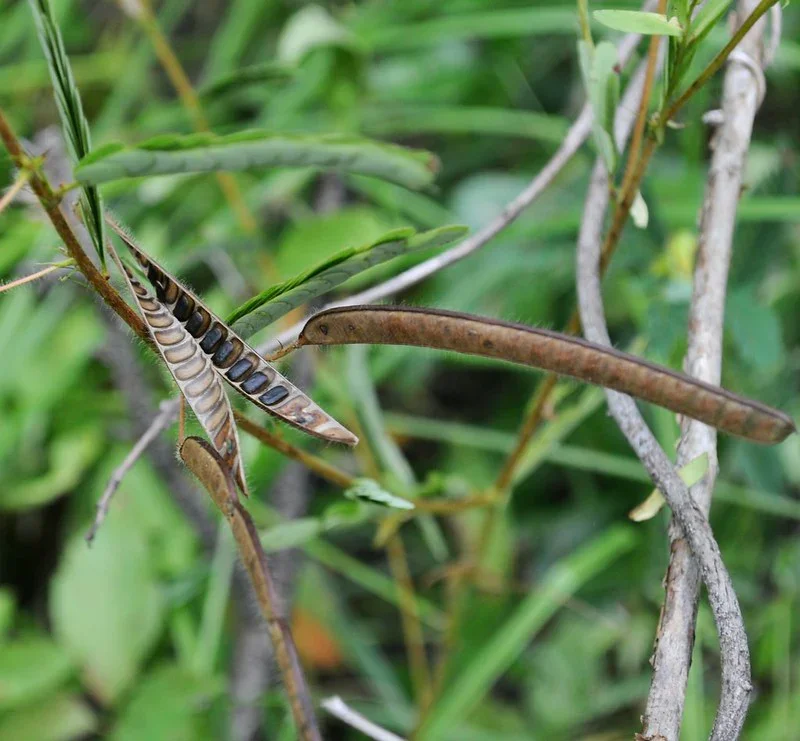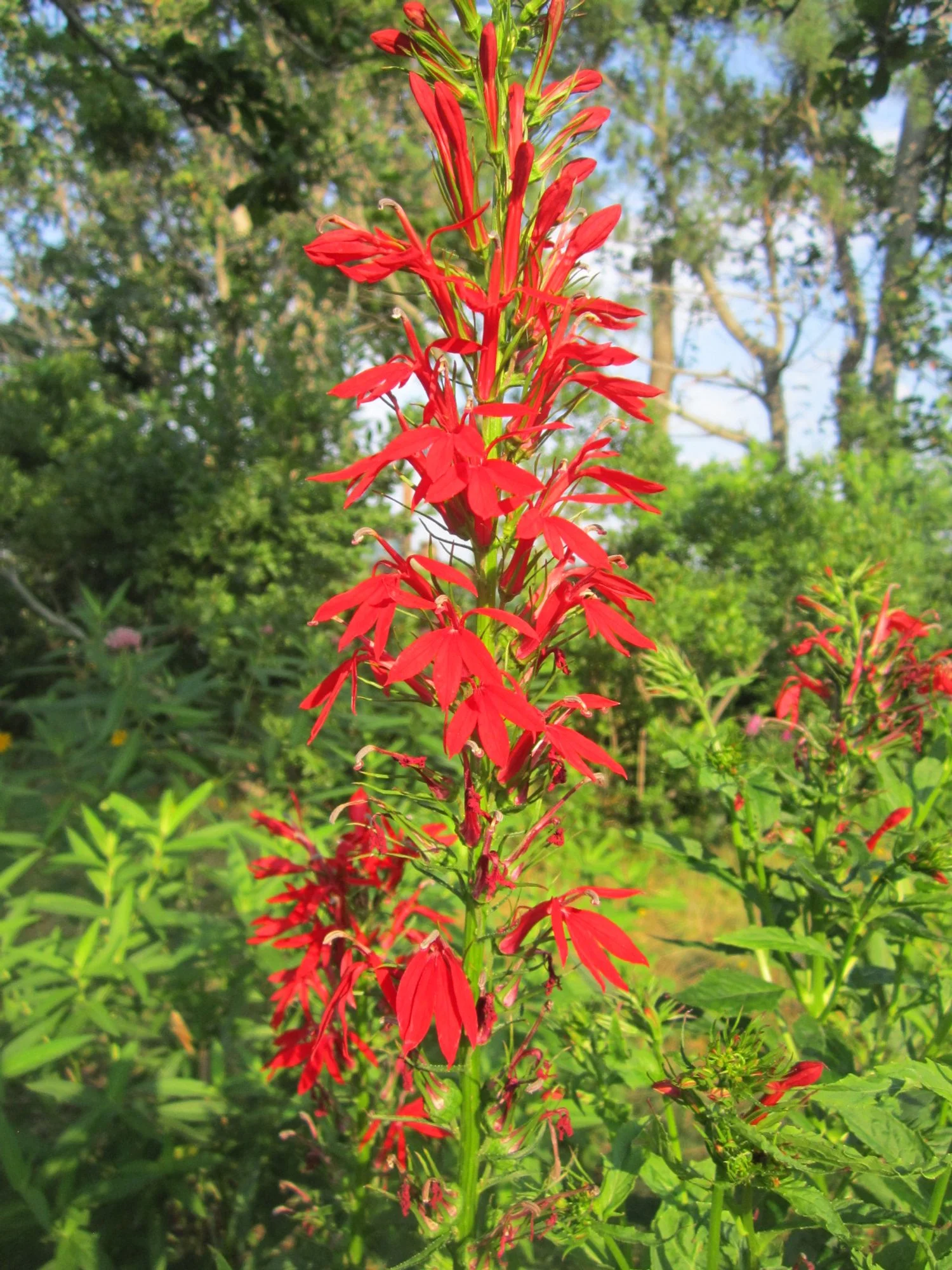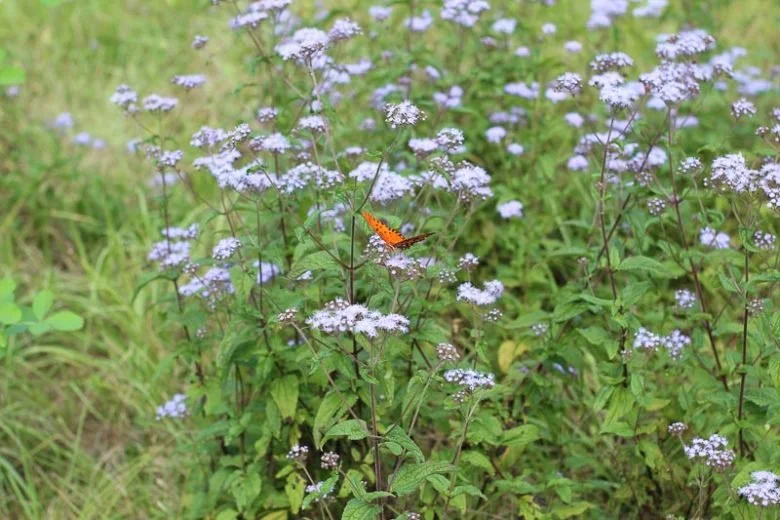SPRING
Meadow Anemone
Anemone canadensis
This is one of the first spring flowers you will see in the meadow; it is common throughout North America. It spreads quickly forming extensive colonies which means it is very good at competing for space in the meadow.
What’s in a name: ‘Anenome’ is from Greek meaning ‘windflower’. Why windflower?Because it was thought the flowers only opened when the wind blew. The ‘canadense’ part is from its Canadian roots where it was first noted by botanists.
Eastern Blue Star
Amsonia tabernaemontana
This is one of the first plants in the meadow to bloom in the spring but look for its golden yellow foliage in the fall. Milky latex material seeps out when stem is broken. This can be mildly poisonous to humans but even more so for dogs and cats. Not surprisingly, it is deer resistant.
What’s in a name: Amsonia honors Dr John Amson (1698m-1765?) an English amateur botanist who lived and worked in Williamsburg Virginia during the colonial period. The epithet honors a German (d. 1590) whose Latin version of his name is Tabernaemontanus.
Foxglove Beardtongue
Penstemon digitalis
Penstemons are among the first plants to appear in the garden in the spring, so don’t expect to find them after June. These delicate white or lavender flowers are not choosy about where they grow and seem to enjoy our meadow. They are certainly a favorite of the bees.
What’s in a name: In Latin, ‘penta’ means 5 and ‘stemon’ means stamen. Stamens are the male reproductive part of a flower which includes as sac of pollen at the end (anther). See if you can count 5 stamens. The common name, Foxglove Beardtongue, may come from the idea that its flowers look like fox’s open mouth with the stamens looking like a tongue. Mmmm……..
Flowering
Seedpod
Butterfly Weed
Asclepias tuberosa
Milkweed is the host plant for the eggs and larva of Monarch butterflies, but this particular variety of milkweed, called Butterfly weed, is not a preferred host for Monarchs because its white sap is not as toxic as sap found in other milkweeds. It is this sap which gives the butterfly a terrible taste, driving off predators. Butterflies love the flowers though.
Native Americans harvested fibers from the dried stems to make ropes and in weaving cloth. Its tough, tuberous root was chewed as a cure for pleurisy and lung ailments.
Look for this incredibly beautiful seed pod in the late summer and fall as it bursts open and the seeds fly off in the breeze. The seed floss has found many uses: stuffing for life jackets, in cleaning up oil spills, and as insulation.
What’s in a name: ‘Asclepius’ was the Greek god of medicine and healing something this plant has been associated with in legend and ‘tuberosa’ refers to its ‘tuberous’ roots. Its common name correctly suggests that it is great at attracting a variety of butterflies.
Wild Bergamont
Mondarda fistulosa (BEEBALM)
Beebalms survive in dry, poor conditions, perfect for our meadow and all the bees and hummingbirds that love their smell. The monarda pictured here, Wild Bergamont, is edible with flavors of basil and citrus. It is said that this plant provided a replacement tea after the Boston Tea Party. It is a good source of bird seed in the fall and winter.
What’s in a name: Nicolas Monardes was a Spanish botanist who documented many plants in the New World in the 16 thcentury. ‘Fistulosa’ means ‘pipe’ or ‘tube’ in Latin and describes the monarda’s hollow stem.
Scarlet Bee Balm
Monarda didyma (BEEBALM)
In addition to its beautiful color, this monarda has deep roots to stabilize the soil and resist drought. It’s also a great pollinator! Look for bees and other insects. The leaves and flowers make a flavorful tea. It is a member of the mint family
Historical significance: because of its bright red color it is believed to have been used as a patriotic tea at the time of the Boston Tea Party.
Purple Coneflower
Echinacea purpura
Purple Coneflower is a wonderful addition to our meadow–eye-catching to humans and insects which means it is an excellent pollinator. It is also very good at carving out its own space in the meadow by giving off a chemical that limits the growth of neighboring plants.
Echinacea is considered to have anti-inflammatory health benefits and may reduce cold symptoms although research is still out on these and other claims. It has been used throughout history and especially by Native Americans.
What’s in a name: ‘Echinos’ means hedgehog or sea urchin in Greek, which fits the description of echinacea’s prickly flower head. ‘Purpura’ of course refers to its beautiful purple color.
Mountain Mint
Pycnanthemum muticum
This wonderful menthol scented plant blooms nearly all summer in the meadow. Rub a leaf to experience why it is also so attractive to insects. Fortunately, though, deer and rabbits are much less fond of this flavor. With densely packed flowers, it offers a field day for nectar loving pollinators.
What’s in a name: ‘Pycnos’ comes from Greek meaning ‘dense’ and ‘anthos’ meaning flower. ‘Mucticum’ refers to the plant’s blunt, not sharp, leaves and flowers. The name aptly describes the soft appearance of the plant.
Brown-eyed Susan
Rudbeckia triloba
Not only does this plant provide vibrant color for most of the season, but its seed heads last through fall and winter providing food for birds. Its large dark center is a beacon for nectar loving insects and its dense growth pattern improves the fertility of the soil. A win win for our meadow.
What’s in a name: Olaf Rudbeck was a Swedish botanist and ‘triloba’ reflects its three lobe leaf structure. Brown-eyed Susan comes from a poetic comparison of its brown center to a girl’s eyes in an old English poem.
SUMMER
False Sunflower
Heliopsis helianthoides
False sunflower thrives even in harsh environments which means it is well suited to our meadow. Because it grows easily and forms dense roots that hold the soil, this unassuming plant is a great boon to any garden.
Historically, false sunflower symbolizes the power of the sun’s energy, a beacon of light amid the greenery.
What’s in a name: Helios’ means ‘sun’ in Greek and ‘opsis” means ‘looks like. ‘Helianthoides’ also means the same – ‘resembling a sunflower’.
Yarrow
Achillea millefolium
This is an incredibly adaptable plant which flourishes in diverse environments and is often found in fields and pathways. It has been spreading happily throughout our meadow anchoring the soil and providing flat topped, nectar rich flowers rich easily accessed by pollinators–bees, butterflies and wasps.
Yarrow is also an important medicinal plant, a chemical storehouse of a variety of acids. It has been used to break a fever, prevent hemorrhaging, and as a poultice on rashes. Native Americans made a tea using the leaves to cure stomach disorders. Not surprisingly, it is highly deer resistant.
What’s in a name: ‘Achillea’ is named after the Greek hero, ‘Achilles’, who is said to have used the plant to treat his battle wounds. ‘Mille’ means 1000 and ‘folium’ means ‘leaf’ which aptly describes the thin, feathery leaves of this plant.
Big and Little Blue Stem
Andropogon gerardii & Schizachyrium scoparium
If you look towards the eastern end of the garden, you will see huge clumps of tall grasses. These are Big Bluestem. In the late summer they are impressive as their seed heads wave in the breeze but while beautiful, they multiply quickly and in fact, have become invasive and extremely difficult to root out. If you visit us in the fall, you will see us digging out huge clumps of them.
Little bluestem is less conspicuous but can be identified by its blue green color which is unique in the garden. Look carefully for it but starting only in June. Its dense tufts provide safe habit and nest places for our rabbits and ground nesting birds. The seeds are an excellent source of energy for birds in the fall and winter.
Grasses play an important role in the meadow by giving it different textures and colors. To see both these grasses waving in the wind is a delight.
What’s in a name: ‘Andropogon’ comes from the Greek ‘andro’ meaning ‘man’ and ‘pogon’ meaning beard. This is a reference to the hair spikelets (flower clusters) which seem to resemble a beard.
Joe Pye Weed
Eutrochium purpureum
Contrary to its name, Joe Pye Weed is not a weed but rather a very beneficial plant in our meadow. It survives in a variety of habitats throughout the US. It loves to tower over other flowers in the meadow reaching heights of 6-10 feet!
What’s in a name: It is said that Joe Pye was a Native American herbalist who used the plants to treat fevers and dysentery in colonial Massachusetts. It is even reported that he used the roots to develop a cure for typhoid, a major killer during the Civil War.
Blazing Star or Gay Feathers
Liatris spicata
These flowers bring a different texture to the meadow in addition to attracting lots of pollinators. Gay feathers are also fire resistant helping them to spread around the world. Unlike most flowers, it blooms from of the top of the spike down. Take a look!
Native Americans used their bulbs to spice foods and the purple blooms are used as dyes that resist fading in the sun. They are associated with bliss and happiness, so enjoy!
What’s in a name: ‘Liatris’ means ‘crowded’ in Greek and refers to the density of flowers on the stalk. ‘Spicata’ is from Latin perhaps suggesting the flower’s spike-like appearance.
Partridge Pea
Chamaecrista fasciculata
This plant starts blooming later in August but you can recognize it before that by looking for its delicate feathery leaves. Partridge Pea is a legume which means it has bacteria in its roots that allow the conversion of nitrogen in the air to a form the plant can use as a fertilizer. This process enriches the soil. It is an annual that reseeds itself so readily that it has spread to all parts of the meadow.
Partridge Pea has an interesting survival strategy: it has small glands where the leaf attaches to the stem. These glands give off nectar which attracts ants which keep away harmful insects that would like to dine on the plant.
Partridge pea was a ceremonial plant for the Native Americans. It has also been seen as a sign of new beginnings and resilience due to its ability to thrive in challenging environments.
What’s in a name: ‘Chamaecrista’ is derived from the Greek, ‘chamae’ meaning low growing or dwarf. It is certainly a lush low growing plant that fills in the empty spaces in our meadow. ‘Fasciculata’ in Latin indicates bunches or clusters of leaves. The name ‘Partridge Pea’ comes from its seed pod which is a great food source for many birds including partridges.
Cardinal Flower
Lobelia cardinalis
The cardinal flower has a tubular structure with the nectar at the bottom of the tube. Only humming birds with their long beaks or butterflies with long tongues can reach this nectar. Although it likes moist areas, it seems to be surviving in our meadow.
The Penobscot people smoked the dried leaves as a substitute for tobacco.
What’s in a name: It is called a Cardinal flower because its brilliant red color resembles that of the ceremonial garments of Roman Catholic Cardinals. ‘Lobelia’ is a new latin word honoring Matthias de Lobel (1538–1616), a Flemish botanist and physician to James I of England.
FALL
Sweet Goldenrod
Solidago odora
There are 25 species of this familiar roadside plant that lends bright yellow color in the late summer and fall. From an ecological perspective, it is the flower that supports the highest number of beneficial insects in this area. Moth and butterfly caterpillars which are excellent food for our song birds thrive on golden rod along with hundreds of native bees.
It spreads easily (sometimes too easily) and is often considered a weed. It releases chemicals into the soil that inhibit competitors, helping it to survive successfully. Goldenrod is often blamed for causing hay fever, but this is not the case. It blooms at the same time as the less showy ragweed which is the true culprit.
What’s in a name: ‘Solida’ means whole in Latin and ‘ago’ means ‘to make’, resulting in ‘to make whole’ referring to the plants historical use for its supposed healing properties.
Blue Mist Flower or Wild Ageratum
Conoclinium coelestinum
Blue Mist Flower is colorful part of fall blooms when blues and yellows are the dominant colors. It is a power player in attracting bees and butterflies. If you are lucky, you might see a Monarch Butterfly enjoying its nectar. Blue Mist Flower can be found across diverse environments because it loves all kinds of soil. As a matter of fact, it spreads so aggressively through its roots and seeds that it is often considered a nuisance – certainly the case in our meadow.
What’s in a name: ‘Conocliniium’ is from Greek, combining ‘kônos’ (cone) and ‘kliníon’ (littlebed), referring to the shape of the flower. ‘Coelestinium’ is derived from Latin meaning ‘heavenly’. From afar, the blue blossoms appear to form a soft heavenly blue cloud.
New England Aster
Symphyotrichum novae-angliae
This plant is important in this meadow because it provides late season nectar for bees and butterflies. We occasionally see monarchs here too. Asters are an evolutionary success story having developed successful wind born seeds which germinate easily and can survive cold winters. They are a valuable source of food for birds at that time of year.
The flower of this plant is actually made up of about 100-150 individual flowers!
What’s in a name: In Greek mythology, the‘aster’ was said to have sprung from the tears of the goddess Asterea when she wept after looking at earth and seeing no stars. The flower is often associated with love, wisdom, and faith.

